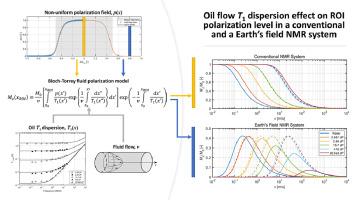In this article we use numerical simulations to study the effect of T1 dispersion on fluid polarization buildup in oil flow to characterize the sensitivity of both a conventional NMR concept (ROI located inside the polarization magnet) and a Earth's field NMR concept (ROI outside and downstream of the polarization magnet) to T1 dispersion of flowing samples. As a polarization field in both concepts we use a 90 cm long Halbach magnet. The T1 dispersion behavior of the oils is based on a set of crude oils that span a viscosity range of 0.7 cP up to 2·104 cP and T1 relaxation measurements for Larmor frequencies between 10 kHz and 20 MHz. Numerical simulations based on solving the Bloch-Torrey equation for the longitudinal magnetization component show that fluid polarization levels in a ROI of a Earth's field NMR system concept are much more strongly affected by T1 dispersion than in the conventional NMR system concept. As a result, we may conclude that the Earth's field NMR system design is less robust for measuring flowing samples that show strong T1 dispersion behavior. In comparison, the conventional NMR system design is relatively insensitive to the effect of T1 dispersion, as T1 dispersion effects were found to form a relatively small correction to the magnetization buildup. The conventional NMR system design consequently is the preferred implementation of a NMR system that operates on fluids with strong T1 dispersion behavior. We show that in the presence of T1 dispersion s = vT1(0)/Lm* may be used as a governing parameter for fluid polarization buildup, where T1(0) is the T1 relaxation time in the center of the polarization magnet, and we show how an modified analytical uniform field model can be used to describe fluid polarization for a uniform flow velocity distribution in the presence of T1 dispersion with an accuracy within 1% for the samples and field distribution considered in this study at industrially relevant flow velocities.


